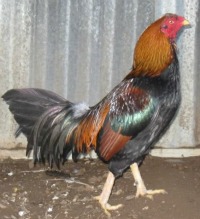Aseel: The Ancient Breed
The Aseel chicken breed is an almost prehistoric looking bird. The breed probably is over two-thousand years old and it is probably the gamiest of all game birds. They will fight at the drop of a hat.
Aseel Facts:
Class: All Other Standard Breeds
Size: Male: 5.5 Ibs. Female: 4 Ibs.
Comb, Wattles & Earlobes: They have a small bright red pea comb and earlobes with no wattles.
Color: The beak is yellow to horn and the eyes are pearl. The shanks and toes are yellow.
Black-Breasted Red: They have standard black-breasted red plumage.
Dark: They have standard dark plumage.
Spangled: They have standard spangled plumage.
Wheaten: They have standard wheaten plumage.
White: They have standard white plumage.
Place of Origin: India
Conservation Status: Critical
Special Qualities: They are the parent to the Cornish breed we know today. They are very aggressive.
Game birds were originally developed for fighting and this breed may be at the top of this class. It is definitely one of the oldest game breeds, well known in its place of origin for over two-thousand years.
It is easy to see that it was bred to fight. With its natural strength and sharp spurs this chicken is well suited for free-range and can defend its self from some day-time predators. It may prefer to roost in trees rather than a coop.
The bird stands very tall with high shoulders and a tail that sits below horizontal. They are remarkably athletic and have tight feathering. Their very gamy look with an erect and muscular body seems to be always at the ready for anything.
The breed has a ancient history in the sport of cock fighting. Both roosters and hens can be aggressive to other poultry showing their aggressive tendencies at a very early age.
There are several different types and sizes including:
There are muffed, tasseled and single combed varieties. The bantams were first developed in the late 1800’s by an Englishman, Wm. F. Entwisle. His blood line lasted about 20 years and disappeared.
Almost 100 years later bantams were resurrected in the 1980’s. A Belgian, Willy Coppens, used Shamo, Indian Game and Reza Asil to recreate the Bantam Asil, which remains very popular today.
Though not prolific layers the females are very good mothers; some lay 6 eggs per year, (as did their Jungle Fowl ancestors), some 40. With strong brooding and protective instincts hens can make great foster mothers of other breeds.
Male or female are known for a feisty nature. Mature roosters are known to fight with deadly results and are still prized for fighting in some countries.
In the US, the American Livestock Breeds Conservancy calls the breed status Critical. The Asil is often cross bred with meat breeds to improve size even though they are slow growing.
A rare Aseel called: Madaroo is a variety with hen-feathered cock birds. Besides hen coloring, roosters lack sickle and long saddle feathers. Also rarely seen outside its native range, there are bearded Aseels called “muffed” and “tasseled” Aseel with tufts on their heads. The Bhaingam is the only variety to sport a large and single red comb, while aligning with all other common traits seen.
The Madras is the tallest often reaching 32”. Even with their large and muscular common type, the breed varies quite a bit, ie; the Kulang Asil to 30” tall, 11 – 15 lbs., the Reza Asil to 20” tall, 4 – 6 lbs., and the Sindhi Asil 3 – 8 lbs., as a few examples. Male or female, Asil or Aseel, this breed has a gammy stature giving some a near wild turkey look.
Fanciers of the Aseel chicken appreciate the hardiness of the breed in physical structure, strength and temperament. These deeply embedded qualities have spread, improved and helped create more hardy modern game breeds around the world.
Outside India, Pakistan and Sri Lanka, “new” countries like Thailand, Japan, Turkey, England, USA and several countries in South America have helped preserve these ancient Asil genetics and fine-tuned them for different regions and purposes. There is a real need for enthusiasts to keep the breed alive.
Although we do not officially fight birds in the US, and more and more countries are outlawing and cracking down on the practice, the Asil still has its place in the poultry world.
Since the Cornish and other breeds have their beginnings in the Aseel, it has a role to play in the conservation of other classic breeds as well as surviving for its own sake.
The breed was first admitted into the APA in 1981.

Custom Search




New! Comments
Have your say about what you just read! Leave me a comment in the box below.